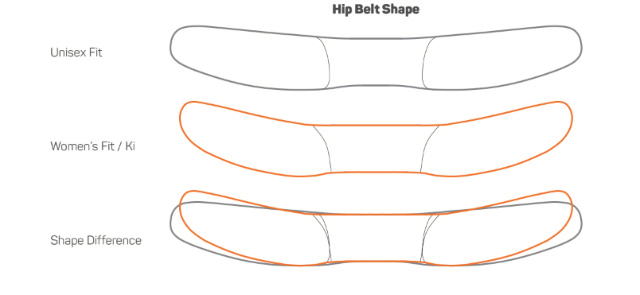J-shaped shoulder straps and S-shaped Shoulder Straps are two different styles of shoulder straps found on backpacks for hiking and backpacking. They differ in their shape, how they conform to the body, and in the placement of the sternum strap affecting comfort and fit.
In the past, most backpacks had J-shaped shoulder straps which are best for men with slim builds. But most manufacturers have now switched to using S-shaped shoulder straps because they are comfortable for all body shapes, particularly women, since the S-shape curves around breasts rather than smashing them flat. S-shaped straps also allow the sternum strap to be positioned higher on the torso above the breasts rather than running over them, which can cause discomfort. If you want J-straps on a backpack, ULA Equipment still offers them as a customization option.
Here’s a breakdown of the key differences:
J-Shaped Shoulder Straps
- Straighter Design: J-shaped shoulder straps have a straighter profile with a slight bend at the top where they connect to the backpack body.
- Less Curved Fit: The straighter design offers less contouring to the body than S-shaped straps.
- Better for: J-shaped straps are a better fit for people with a narrower build, flatter shoulders, or a smaller chest. They can also work well for those who prefer a less constricting feel around the chest.
S-Shaped Shoulder Straps
- Curved Design: S-shaped straps have an S-curve that follows the natural contour of the shoulders and chest.
- Body Conforming: The curve is designed to cup around the chest and breasts, providing a more anatomical fit and potentially reducing pressure points.
- Better for: S-shaped straps are generally considered a better fit for people with broader shoulders, rounded shoulders, a larger chest, or breasts. But they are usually comfortable for people with a more average build.
- Look Out For: Manufacturers put different amounts of curve into their S-shapes. If you are large-chested, look for shoulder straps that are attached to the top of the pack using a webbing strap rather than being sewn directly to the pack’s back panel. The webbing straps allow the shoulder straps to auto-rotate around the chest providing a more comfortable fit. Zpacks is one of the few lightweight backpack manufacturers to provide this auto-rotation capability.
Choosing Between J-Shaped Straps and S-shaped Shoulder Straps
- Body Type: While there are general recommendations, the best way to choose is to try on backpacks with both strap styles and see which feels most comfortable and offers the best fit for your body type.
- Personal Preference: Some people simply prefer the feel of one strap style over the other, regardless of their body type.
- Adjustability: Look for backpacks with adjustable straps to fine-tune the fit for your torso length and shoulder width, regardless of the strap shape. For example, it should be easy to move the sternum strap up or down. Load lifters can also help put less pressure on the shoulder straps and more on your hips.
Additional Considerations
- Hip belt: A well-fitting hip belt is crucial for transferring weight from your shoulders to your hips, which improves comfort on long hikes. Women, in particular, should look for hip belts that have curved padding to wrap over their hips instead of the standard straight hip belts designed for men. Granite Gear makes the best backpack hip belts for women, by far, and has always led the market in this regard.

Pack Weight: The weight of the backpack you’ll be carrying also plays a role in comfort. Choose a pack with a capacity appropriate for your needs and pack efficiently to avoid overloading it.
By understanding the differences between J-shaped shoulder straps and S-shaped and and considering your body type and preferences, you can choose a backpack that provides a comfortable and supportive fit for your next backpacking trip.
SectionHiker is reader-supported. We only make money if you purchase a product through our affiliate links. Help us continue to test and write unsponsored and independent gear reviews, beginner FAQs, and free hiking guides.
